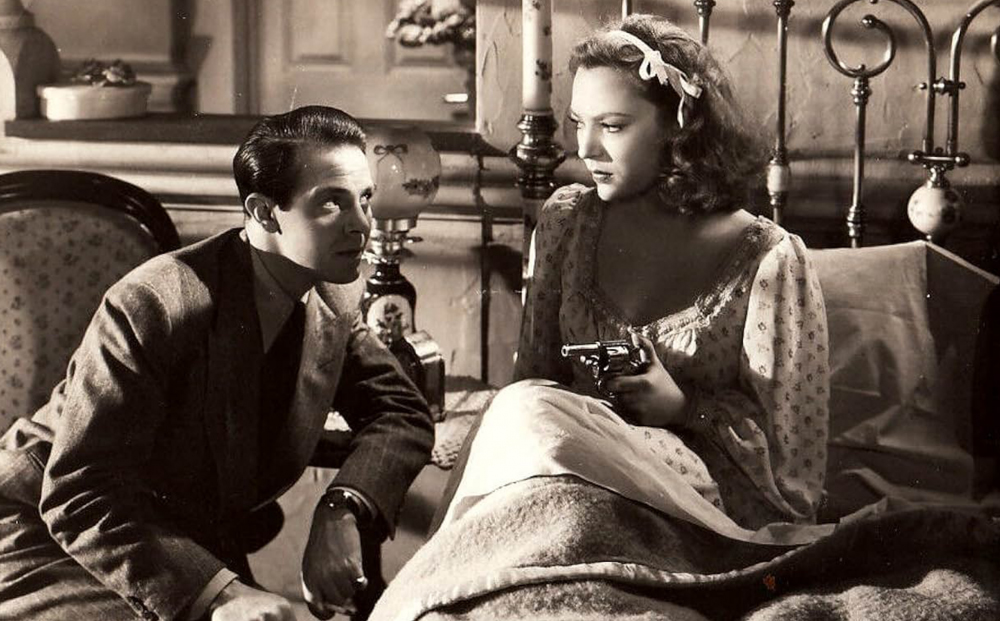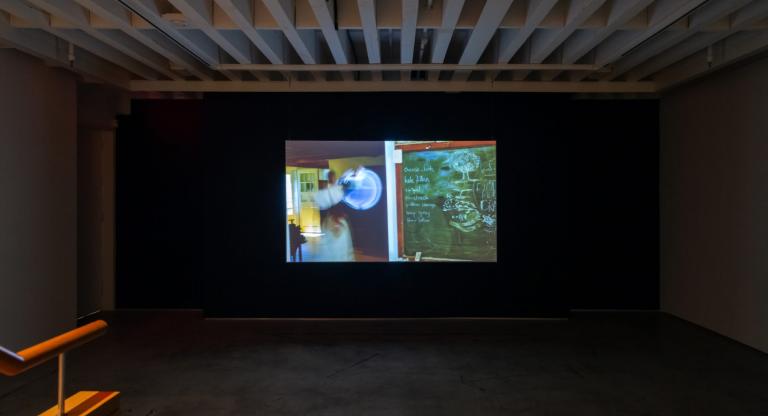René Clair’s And Then There Were None (1945) was the first of many—and often considered the best—adaptations of the 1939 Agatha Christie novel published under the same title in the United States. One of the best-selling books of all time, the classic thriller takes its inspiration from a 19th century nursery rhyme, with ten strangers on a mysterious island picked off one-by-one, each in a manner inspired by the rhyme’s morbid stanzas. The murders, as described by Christie, are rather gruesome and in some cases quite baroque; a mounting sense of dread and the suspense of deaths foretold plague the book’s characters, as well as the reader. That the novel’s inspiration came from children’s entertainment may seem particularly macabre, but it’s not all that unusual in the genre, take Sue Grafton’s ABC oeuvre, for example. In fact, this was a frequent trend in Christie’s work (One, Two, Buckle My Shoe, 1940; Three Blind Mice, 1950; Hickory Dickory Dock, 1955; and others). Despite their hefty body counts and the horrors they often depicted simmering below the surface of British middle-class society, Christie’s murder mysteries were never without their brittle ironies and the cheeky satisfaction of a plausible if impossible-to-predict resolution, experienced by the reader simultaneously as it was described by the one who solved the case. Christie was nicknamed “the doyenne of Coziness” by the American mystery bookseller Dilys Winn, the grim qualities of her preferred subject matter notwithstanding.
In Clair’s adaptation, the windswept halls of the abandoned mansion setting are appropriately frigid for a murder-filled weekend on a remote island, and the offscreen kills are not without a certain chilling quality. But the tone throughout is frankly lighthearted, as befits the director’s preceding output. In typical Clair fashion, the opening motorboat sequence would read as well as that of a silent comedy as a sound-film murder mystery: from the tell-tale lean of Dr. Armstrong’s apparent drunkenness (played convincingly by Walter Huston), to the uptight Mrs. Brent (a fantastic Judith Anderson, as always) turning green from a neighbor’s cigar smoke, and the queasiness that passes down the line of passengers upon seeing the helmsman make fast work of a sandwich. Later, as the crime within each character’s past is revealed, they turn to face the camera for a moment, a fourth-wall break that humanizes these accused killers more than anything. And slapstick ensues throughout, with hilarious use made of keyholes, mutual suspicions, and the free-flowing alcohol enjoyed by all. The butler Rogers is the butt of several jokes, even as his wife is one of the first victims, and even as he continues to serve cold meat and stir cocktails without her help.
In Forever England: Femininity, Literature and Conservatism Between the Wars, the critic Alison Light describes And Then There Were None as Christie’s “most inward, least comic” work. She writes that the novel takes “the logic of her own fears about the social fabric to its extreme conclusion: every person is both a potential murderer and a potential victim. As a metaphor for the corruptions of insularity, it can be read on many levels, not least as an image of the mental universe of the British middle classes in the late 1930s, shut in and clannish, increasingly marooned.” Clair’s apparent affection for the foibles of these imperfect people might be seen as counter to Christie’s critique, but when everyone smiles and continues to sit at the dining table as the murders mount and the killer is determined to be among their own ranks, a corruption at these ordinary folks’ core is revealed. Screenwriter Dudley Nichols (of Bringing Up Baby and 14 Ford films) sticks faithfully to the happier ending Christie crafted in 1943 when adapting her own novel for the stage. Yet what could be more troubling than the romantic union, between the young Mr. “Lombard” and the tremulous Ms. Claythorne, teased from the guest’s arrival in their windblown coffin and solidified by the film’s rather pat conclusion?
What needs remarking is the film’s greater horror, hiding in plain sight and inherited from the source material: the inspiring, racist nursery rhyme, initially written into a minstrel song in 1868 as “Ten Little Indians” and adapted in the UK to “Ten Little N—s” in 1869. The latter was Christie’s title, printed in the United Kingdom from the novel’s publication in 1939 all the way up until a reprint in 1985; in the United States, it was given the sanitized name And Then There Were None in its first publication in 1940). Light writes that Christie uses this to contribute to the novel’s suspense—that in contrast with the remote locale of Joseph Conrad’s Heart of Darkness, for example, “Christie’s location is both more domesticated and privatized, taking for granted the construction of racial fears woven into psychic life as early as the nursery.” The American version of the rhyme repeats constantly in the film, on the soundtrack, in the dialogue, and through an ugly ceramic centerpiece that marks the murderer’s progress; as such, the playful thrills and brisk entertainments of Clair’s film cannot, in the end, overcome the brutality that such a structuring device contains.
And Then There Were None screens tonight, April 1, and tomorrow, April 2, at Film Forum as part of the series “René Clair.” Tonight’s screening will be presented on 16mm.


